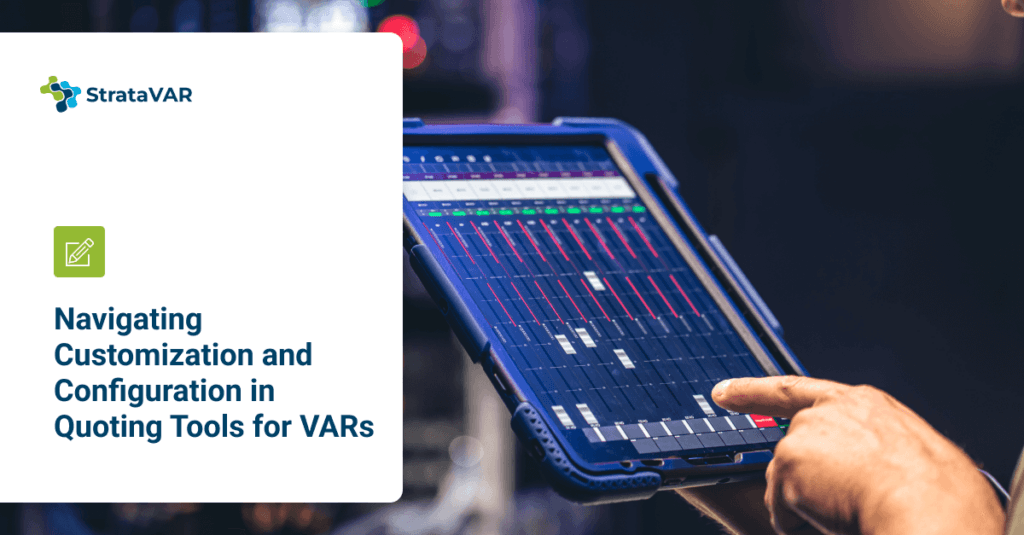A Quoting Tool That Works for You: Navigating Customization and Configuration in Quoting Tools for VARs
Each business is unique, with its own set of nuances, and this is particularly true for ICT Value-Added Resellers (VARs). A quoting tool that aligns with and supports your business approach, sales processes, and customer engagement strategies can transform your operations. Proper alignment not only streamlines internal processes and enhances collaboration among teams—from sales to operations and finance—but also boosts customer satisfaction throughout the sales journey. Yet, many solutions promise to streamline sales operations processes but fall well short and become an even larger burden to maintain.
To navigate these challenges, it’s crucial to select a platform that is intuitive, designed for your specific business type, and capable of adapting through customization and configuration to meet your evolving needs. Selecting a tool that supports scalability and future-proofing new business models and processes makes it feasible to expand or pivot the tool’s capabilities to meet emerging business models. This ensures it remains a valuable asset through various growth phases and technological advancements. This approach ensures that the software grows and evolves alongside your business, providing value over time.
A Tailored Quoting Solution for ICT VARs
For ICT VARs, a quoting solution should be more than a generic tool—it should encompass features and capabilities specifically tailored to the needs and common requirements of value-added reselling, including integrations with manufacturers like Cisco and distributors like TDSynnex. While the basic product should competently meet the core needs of most VARs, the journey doesn’t end there. As your business grows and your needs evolve, the tool’s adaptability through customization and configuration becomes essential.
Customization vs. Configuration
Configuration and customization are two strategies that enhance the core functionalities of your quoting software, allowing it to better serve unique business requirements. But what exactly differentiates the two?
- Configuration involves setting up software features that are already built into the software. It’s about tailoring the existing functionalities to better fit the way your business operates. This could involve setting up user roles and permissions, choosing which data fields are displayed, or adjusting integration settings with other tools.
- Customization, on the other hand, goes a step further by modifying existing features or adding new features that are not part of the core software package. This could mean developing new modules or extensions specifically designed to address unique aspects of your business operations.
Key Considerations for ICT VARs
Choosing a highly adaptable quoting tool involves more than just evaluating its current capabilities. Here are some critical factors to consider:
- Flexibility of Customizations: Customization is crucial for ensuring that your quoting tool not only meets current needs but also adapts seamlessly as your business evolves. Allowing customizations to be handled by your internal IT staff, external developers, or in collaboration with the software solution’s team offers strategic advantages. This approach grants autonomy and enhances responsiveness to market changes or strategic shifts without reliance solely on the software provider’s timeline and availability. It also promotes cost efficiency by enabling competitive pricing and budget control, as you can select the most cost-effective provider for each specific customization need. Additionally, engaging diverse teams brings varied expertise and innovative solutions, enriching the tool’s functionality with new technologies and perspectives that closely align with your business goals.
- Ownership of Customizations: It is vital that any customizations made to your quoting tool remain under your company’s control. This exclusivity not only ensures that the unique aspects of your tool, which give your business a competitive edge, remain proprietary but also protects your strategic interests. By retaining ownership of these customizations, you safeguard your intellectual property and ensure that key innovations developed for your platform do not become generalized solutions accessible to your competitors. This ownership empowers your company to maintain a distinctive position in the market, leveraging tailored features that are closely aligned with your business processes and long-term strategies.
- Continuity and Alignment: Ensuring that customizations are compatible with new software updates is crucial for maintaining operational stability. This continuity allows your quoting tool to remain effective and reliable, even as the underlying software evolves. Regular updates often bring important security patches and new features that can enhance functionality, but they can also disrupt custom features if not properly aligned. By prioritizing continuity in your customization strategy, you ensure that these updates enrich rather than hinder your quoting processes. Furthermore, maintaining alignment between your custom solutions and standard updates helps in mitigating potential vulnerabilities and optimizing performance, thereby sustaining the tool’s efficiency and security over time.
Moving Forward with a Customizable and Configurable Tool
For ICT VARs, the right quoting tool is one that not only meets the current needs but can also adapt to changing demands. Here’s how you can ensure you are making the right choice:
- Evaluate the Software’s Core and Its Adaptability: Start with a tool that adequately addresses the basic needs of your business. From there, assess how well it can be configured or customized to align with your specific operational needs.
- Consider the Vendor’s Support and Development Capabilities: Choose a software provider that not only offers robust support but also demonstrates a commitment to continuously improving their product. This includes their willingness to work with you on customizations that cater to your unique requirements.
- Plan for the Future: Consider not only your current needs but also potential future requirements. Opt for a tool that can scale and evolve as your business grows and changes, minimizing the need for frequent replacements.
By carefully selecting a quoting tool that offers both excellent configurability and customizability, ICT VARs can ensure they invest in a solution that not only meets the current demands but also adapts to future challenges and opportunities. This strategic approach to selecting your software tools not only optimizes your operational efficiency but also enhances your ability to serve your customers effectively.

